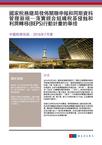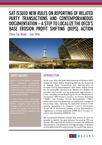
These new reporting guidelines are substantial changes to the existing rules, replacing the applicable sections in the existing regulations ( i.e., Chapters 2 and 3, and Articles74 and 89 of the existing transfer pricing documentation regulations in Circular Guoshuifa [2009] No.2 (“Circular 2”) and Circular Guoshuifa [2008] No. 114).We recommend taxpayers should take actions as soon as possible to identify the gaps between the existing TPD and the new TPD requirements and start to prepare the additional documentation and disclosure to bridge the gaps, as Bulletin42 will apply from 2016 and onwards. For Local Files, there is only one more month for preparation, as compared to Circular 2. For Local Files and the newly added Special Issue Files, the deadline for preparation is June 30 of the following year. The deadline for preparation for the 2016 year would be June 30, 2017.
BACKGROUND
The SAT released a discussion draft of the Implementation Measures of Special Tax Adjustment (hereinafter referred as “Draft Circular 2”) on 17 September 2015 for public consultation. Draft Circular 2 is a very comprehensive document, essentially a localization of Organization for Economic Co-operation and Development (“OECD”)’s Base Erosion Profit Shifting (“BEPS”) Action Plans No 8 – 10 and 13 in China. It was expected the Draft Circular 2 would be finalized to replace the existing Circular 2, but instead the SAT released a refined transfer pricing compliance requirement separately in the form of Bulletin 42. We expect the SAT will issue the remaining parts of the Draft Circular 2 in the form of various Public Notices in the future.
DETAILED ANALYSIS OF BULLETIN 42
Bulletin 42 introduces a three tier documentation framework, as set out in the OECD’s BEPS Action No 13. It however adds a Special Issue File and also requires technical analysis and consideration of positions that are particularly relevant to the China market – for example, the impact of location specific advantages on pricing arrangements, a stand which has been vigorously pursued by developing countries such as China and India. Bulletin 42 also addresses practical issues that have been the focus of the Chinese tax authorities.
1. Related Party Relationship Definitions
Bulletin 42 expands the existing definitions to ensure that relationships between natural persons, e.g. husband and wife, blood relationship, siblings etc are taken into account when considering the relationship between two parties. The Bulletin also clarifies issues such as the determination of ratio of debts to equity in determining whether a lender and a borrower are related parties. It also provides that two parties will be considered related if they have“other substantial common interests”. The types of related party transactions are updated and follow those covered in the Draft Circular 2. These includetangible assets, financial assets ( e.g., equity investment), intangible assets, financing and service transactions.
2. Documents To Be Prepared
Master File: If the company meets either of the following criteria, a Master File would be required to be prepared:
- Has cross-border related party transactions and belongs to a group which has prepared a Master File, or
- The total amount of related party transactions exceeds RMB 1 billion. The deadline for preparation of the Master File is within twelve months of the fiscal year end of the group’s ultimate holding company.
Local File: The thresholds for requirement to prepare a Local File are dependent on the types of related party transactions. They are:
- RMB 200 million for tangible assets transfer ( in the case of toll manufacturing, in which the toll manufacturer would not possess title to the raw material or the finished goods and would only charge a processing fee, the amount in the annual customs record would be used to determine the quantum of related party transactions);
- RMB 100 million for financial assets transfer;
- RMB 100 million for intangible assets transfer; and
- RMB 40 million for other related party transactions in total, e.g., services
Financial assets transfer is a newly added related party transaction. Financial assets refer to accounts receivable, notes receivable, other account receivables, equity investment, debt investment and financial derivative assets. Similarly, intangible assets transfer is newly added.
Special Issue File: There is no specific threshold criterion for the Special Issue file. The Special Issue File is required for taxpayers engaging in cost sharing agreement, or falling under the thin capitalization requirement. The additional required information under Bulletin 42 is listed as below:
- Cost sharing agreement: the use of the results of the cost sharing agreement by the non-participants, and the allocation method of the costs among the participants, and the calculation of the anticipated benefits, including the selection of parameters, calculation method and reason of change, if any;
- Thin capitalization: to prove the related party financing’s compliance with the arm’s length principle. If an entity breaches the thin capitalization ratio, in order for interest incurred on related party’s debt to be deductible, it must be in accordance with the arm’s length principle.
When the tax authority makes a request to the entity to submit the above TPDs, the deadline for submission is within 30 days upon the request is made.
3. Identify and Bridge the Gaps
In order to be ready for the new TPDs, it is critical for taxpayers to know the key differences between the requirements under Bulletin 42 and those under Circular 2, and get the resources and information ready for the preparation under Bulletin 42.
The key differences are laid down in the following:
Master File: The Master File is focused on providing details of the overall operation of the multinational enterprises group (“MNE”). Bulletin 42’s requirements are generally consistent with those recommended by BEPS Action No 13.
The information required includes (i) organizational structure of the MNE; (ii) description of the MNE’s business, including information on what the main business is and what the key value drivers are; (iii) Intangible, including where strategic management, research and development activities are performed and details of legal ownership on intangible, agreements on the development and use of the intangible, transfer pricing policy relating to the intangible and how the intangible is transferred among the group members and how the intangible is exploited; in essence, which entities in the MNE perform the Development, Enhancement, Protection, Maintenance and Exploitation (“DEMPE”) functions in respect of the intangible; (iv) the MNE’s financing arrangement and (v) the financial and tax status.
In addition, the following would also be required if they are relevant:
- Business restructuring and the transfer of function, risk and assets within the group;
- The function, risk, assets and employees of the principal research and development facilities;
- The names and locations of the member entities for which the group shall prepare and submit the CbCR, if any; and
- List and brief description of the group’s existing bilateral advanced pricing agreements, if any.
Any MNE headquartered in China, or Chinese subsidiaries of MNEs which have not prepared the Master File at the group level is recommended to start working on the structure and framework of the Master File if it meets the criteria. We believe one of the key challenges is to identify the key value drivers of the group, and the relevant entity’s principal contribution to the value creation, which requires a comprehensive value chain analysis of the MNE.
Local File: The Local File would consist of three major sections: (i) Company profile; (ii) Description of the related party transactions and (iii) Financial information.
On company profile, the management structure, description of business and the major competitors of the entity would be described.
On the related party transaction section, where the functional and comparability analysis is described, it would have the following elements:
(i) description and amount of related party transactions, details of the relationship;
(ii) description of important inter-company agreements;
(iii) functional analysis, comparability analysis and change analysis;
(iv) TP methodology, important assumption and multiple years’ data;
(v) internal/external comparable, adjustments and financial data for the TP analysis;
(vi) disclosure of any Advanced Pricing Agreements or Advanced Rulings.
Lastly, on financial information, the actual financial data of the company, the financial data of the comparable and the source of comparable are analyzed and disclosed.
Compared to the previous TPD requirements, the Local File requires significantly greater information disclosures and analysis.
The new items required include:
1. Key factors affecting pricing of transactions, taking into account of Location Specific Advantages;
2. Value Chain Analysis, including the transaction flows within the group, the financial information of the participating entities in the value chain and the profit allocation in the value chain, taking into account of Location Specific Advantages factors;
3. Financial data: financial data for each type of business and products;
4. Equity transfer analysis (if relevant): an overview of equity transfers, information on the equity transferred, due diligence reports and valuation report of any underlying asset for the transferred equity;
5. Related party service analysis (if there is any): Separate analysis on related party services, including the benefits for each party from the service transactions, methodology for determining the service costs, service items, service amount, allocation standards etc, as well as information on any same or similar service transactions entered into with third parties.
With respect to the above additional requirement, the most difficult would be the Value Chain Analysis. They are not just intended for the immediate related party transactions covered by the TPD of the entity, but for the overall MNE group, which will require an in-depth functional, risk and economic analysis on the MNE group’s overall business. Without an in-depth analysis of the overall business, there would be bound to have conflicts and inconsistency among the group companies. MNEs should take a consistent and coordinated approach to prepare the Local Files for their Chinese subsidiaries.
It is expected that in future transfer pricing audits, if there are no appropriate comparable available, the tax authorities would use profit split or contribution analysis based on the value chain analysis to determine the transfer pricing adjustment.
4. Related Party Forms
In addition to the Master File, Local File and Specific Issue File, Chinese enterprises have always been required to attach Related Party Forms with their annual tax return.
The number of Related Party Forms has been significantly increased, compared to those required under the replaced Circular Guoshuifa [2008] No. 114. Despite the huge increase of requirement, taxpayers would need to submit the new Related Party Forms under Bulletin 42 with the annual income tax filing, starting with the 2016 filing. Taxpayers may apply for an extension according to the provisions in the Tax Collection and Administration Law and its detailed implementation rules. These new forms also include the CbCR form, if it is required.
5. CbCR Forms
The CbCR Forms are required for the Chinese resident enterprises if:
• it is the ultimate holding company of the MNE group with consolidated revenues over RMB5.5 billion,(approximate equivalence of EUR750 million as recommended by the OECD) or
• it is nominated as the CbCR Reporting Entity.
Of interest to some taxpayers, if the ultimate parent company of an MNE is a Chinese tax resident enterprise and the information may be relevant to the national security, then part or all of the CbCR can be exempted based on the relevant regulation.
The annual CbCR filing requirement mainly applies to the ultimate holding companies in China. There are however provisions that allow the Chinese tax authorities to request copies of CbCR from overseas tax authorities, as well as provisions to require the information from the local entities if overseas tax authorities do not provide the information. We expect fundamental challenges for preparing CbCR include:
1. reconciliation between global and local reporting, which may create potential data mismatch issues; and
2. data collection and extraction, which may create additional processes and accounting tasks for the MNE’s tax departments. In view of the above challenges, we suggest taxpayers conduct a trial run using the 2015 financial data.
The Takeaway
The transfer pricing structure under the new international tax landscape reflects the principle that profit allocation matches with value creation. Bulletin 42 is the first step undertaken by the Chinese tax authorities towards this objective. It is worth noting that the Multilateral Convention on Mutual Assistance in Tax Matters comes into force for China with implementation from 1 January 2017 (see SAT Bulletin [2016] No.4). More than 130 countries will be able to exchange tax information with China. In addition, on 12 May 2016, the SAT signed the “CbC Multilateral Competent Authority Agreement” with 44 countries (the numbers keep increasing) including Canada and India, agreeing to the automatic exchange of CbCRs for MNEs. Also, many countries, including United States, Japan, Korea, United Kingdom and the EU are drafting or have issued their regulations for CbCRs. Hong Kong and Singapore have accepted to be an OECD Associate Member with respect to the BEPS Action Plans and will also be introducing the TPD requirement and CbCR in the near future. Therefore, MNEs will face stricter requirements on information transparency and compliance. MNEs should take actions immediately to address the requirements, and also assess their current transfer pricing structure in light of these requirements.


